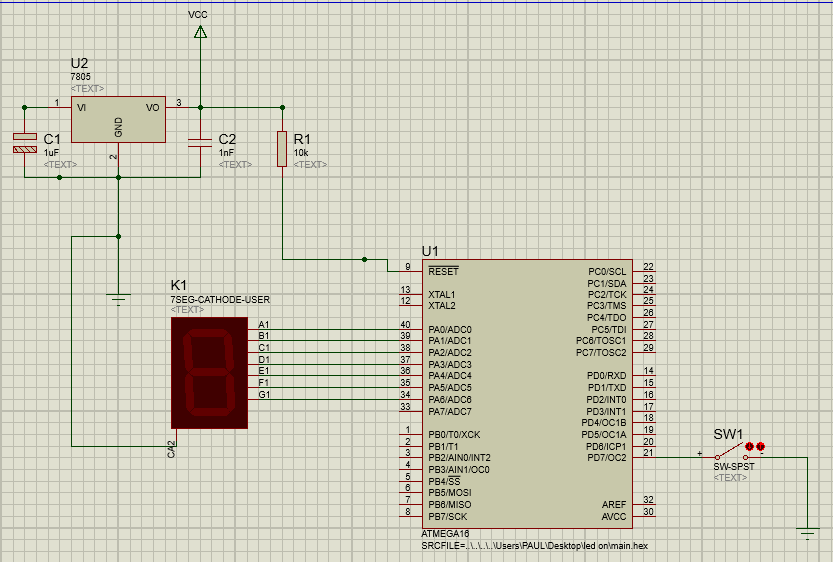Microcontrollers
Programming a microcontroller is a difficult task because it depends on understanding its functionality. The datasheet of a microcontroller, has hundreds of pages so it takes time to read it and even more time to interpret it. After that follows the datasheets of various interfaces and so on.
During my study, I had the opportunity to find on youtube, some good tutorials of AVR microcontrollers by Patrick Hood-Daniel. This guy covers many topics but if you are a beginner you’ll not understand much of them. So I recommend starting first with some mikroC tutorials and pic microcontrollers. MikroC is an embedded-C compiler that runs an user friendly C language and gives you a basic understanding of how microcontrollers works.
Digital dice

This project consist of an Atmega16 chip connected to a 7 segment display. When touching a switch wired to the microcontroller you can see on the display, randomly generated numbers from 1 to 6. For the results, you can watch the video below. The project was developed by AVR Tutorials. I kept the author copyrights in the header of the program but I have to mentions that the website doesn’t exist anymore at least with the old name. For programming the microcontroller, I have used an usbasp programmer and setup the frequency to 4MHz by changing the fuse bits. Beside the main function in the program, there are 4 more that deals with the functionality of the microcontroller: one translates the decimal number from 1 to 6 into a physical way of lighting the 7 segment display, one deals with seeping numbers from 1 to 6 simulating the rolling dice when pushing the touch, one deals with port, timer and global interrupts initializations, and one triggers interrupt service routine for timer overflow. The last one helps getting a random number from 1 to 6 in the main function.
/*
* DigitalDice_SingleDigit.c
* Written in AVR Studio 5
* Compiler: AVR GNU C Compiler (GCC)
*
* Created: 5/27/2011 10:50:48 PM
* Author: AVR Tutorials
* Website: www.AVR-Tutorials.com
*
* Description: AVR C program for ATMega16 Seven Segment
* Single Digit Digital Dice Project
*/
#define DicePort PORTA
#define DicePortDDR DDRA
#define SwitchPortDDR DDRD
#define SwitchPort PORTD
#define SwitchPin PIND
#define RollSwitch 7
#define F_CPU 4000000UL
#include <avr/io.h>
#include <stdlib.h>
#include <util/delay.h>
#include <avr/interrupt.h>
unsigned char seed = 0;
/*Declaration of functions. The implementation of these */
/*function are done below the main() function*/
unsigned char digit_to_7segval(unsigned char digit);
void roll_dice(unsigned char times);
void init();
ISR(TIMER0_OVF_vect);
int main(void)
{
unsigned char digit = 0;
init(); // Configure the Microcontroller
/*Do forever*/
while(1)
{
if(!(SwitchPin & (1<<RollSwitch)))
{
/*Roll the dice 2 times*/
roll_dice(2);
/*Generate an integer based random number between */
/*1 and 6 inclusive and store it in digit*/
seed = (seed*17)+21;
digit = seed % 6;
digit++;
/*Get the Seven Segment value of the random number*/
/*and output it to the pins of port B*/
DicePort = digit_to_7segval(digit);
}
}
}
/*Configuration for the microcontroller*/
void init()
{
/*Configure DicePort as an output port*/
DicePortDDR = 0xFF;
/*Configure SwitchPort as an input port*/
SwitchPortDDR = 0x00;
/*Enable SwitchPort pull-up resistors*/
SwitchPort = 0xFF;
TCCR0 = 0x01; // Enable Timer0 with no prescalar
TIMSK = 0x01; // Enable Timer0 interrupt
sei(); // Enable Global Interrupt
}
/*This function takes an character value and return the */
/*and return the value to be outputted to display that */
/*character on a seven segment display*/
unsigned char digit_to_7segval(unsigned char digit)
{
unsigned char segval = ‘0’;
if(digit == 1)
segval = 0x06; // 7-Seg Value for Digit 1
else if (digit == 2)
segval = 0x5B; // 7-Seg Value for Digit 2
else if (digit == 3)
segval = 0x4F; // 7-Seg Value for Digit 3
else if (digit == 4)
segval = 0x66; // 7-Seg Value for Digit 4
else if (digit == 5)
segval = 0x6D; // 7-Seg Value for Digit 5
else if (digit == 6)
segval = 0x7D; // 7-Seg Value for Digit 6
return segval;
}
/*This function simulates the rolling of the dice*/
void roll_dice(unsigned char times)
{
unsigned char i;
for(i=0; i<times; i++)
{
DicePort = 0x06; // Display #1 on dice
_delay_ms(100);
DicePort = 0x5B; // Display #2 on dice
_delay_ms(100);
DicePort = 0x4F; // Display #3 on dice
_delay_ms(100);
DicePort = 0x66; // Display #4 on dice
_delay_ms(100);
DicePort = 0x6D; // Display #5 on dice
_delay_ms(100);
DicePort = 0x7D; // Display #6 on dice
_delay_ms(100);
}
}
/*Interrupt Service Routine for timer overflow*/
ISR(TIMER0_OVF_vect)
{
seed++; // Increment the value in the variable seed
}


